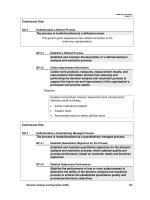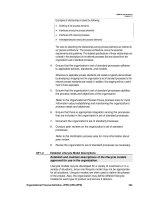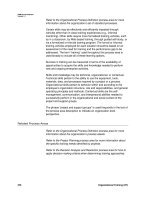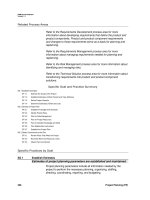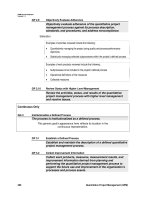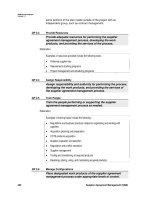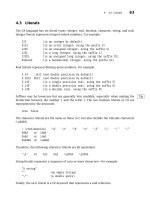CMMI for Development phần 4 pdf
Bạn đang xem bản rút gọn của tài liệu. Xem và tải ngay bản đầy đủ của tài liệu tại đây (232.18 KB, 42 trang )
CMMI for Development
Version 1.2
Decision Analysis and Resolution (DAR)
143
Continuous Only
GG 3 Institutionalize a Defined Process
The process is institutionalized as a defined process.
This generic goal's appearance here reflects its location in the
continuous representation.
GP 3.1 Establish a Defined Process
Establish and maintain the description of a defined decision
analysis and resolution process.
GP 3.2 Collect Improvement Information
Collect work products, measures, measurement results, and
improvement information derived from planning and
performing the decision analysis and resolution process to
support the future use and improvement of the organization’s
processes and process assets.
Elaboration:
Examples of work products, measures, measurement results, and improvement
information include the following:
• Number of alternatives considered
• Evaluation results
• Recommended solutions to address significant issues
Continuous Only
GG 4 Institutionalize a Quantitatively Managed Process
The process is institutionalized as a quantitatively managed process.
GP 4.1 Establish Quantitative Objectives for the Process
Establish and maintain quantitative objectives for the decision
analysis and resolution process, which address quality and
process performance, based on customer needs and business
objectives.
GP 4.2 Stabilize Subprocess Performance
Stabilize the performance of one or more subprocesses to
determine the ability of the decision analysis and resolution
process to achieve the established quantitative quality and
process-performance objectives.
CMMI for Development
Version 1.2
Decision Analysis and Resolution (DAR)
144
Continuous Only
GG 5 Institutionalize an Optimizing Process
The process is institutionalized as an optimizing process.
GP 5.1 Ensure Continuous Process Improvement
Ensure continuous improvement of the decision analysis and
resolution process in fulfilling the relevant business objectives
of the organization.
GP 5.2 Correct Root Causes of Problems
Identify and correct the root causes of defects and other
problems in the decision analysis and resolution process.
CMMI for Development
Version 1.2
Integrated Project Management +IPPD (IPM+IPPD)
145
INTEGRATED PROJECT MANAGEMENT +IPPD
A Project Management Process Area at Maturity Level 3
Purpose
The purpose of Integrated Project Management (IPM) is to establish
and manage the project and the involvement of the relevant
stakeholders according to an integrated and defined process that is
tailored from the organization’s set of standard processes.
IPPD Addition
For IPPD, Integrated Project Management +IPPD also covers the
establishment of a shared vision for the project and the establishment of
integrated teams that will carry out objectives of the project.
Introductory Notes
Integrated Project Management involves the following:
• Establishing the project’s defined process at project startup by
tailoring the organization’s set of standard processes
• Managing the project using the project’s defined process
• Establishing the work environment for the project based on the
organization's work environment standards
• Using and contributing to the organizational process assets
• Enabling relevant stakeholders’ concerns to be identified,
considered, and, when appropriate, addressed during the
development of the product
• Ensuring that the relevant stakeholders perform their tasks in a
coordinated and timely manner (1) to address product and product
component requirements, plans, objectives, problems, and risks; (2)
to fulfill their commitments; and (3) to identify, track, and resolve
coordination issues
IPPD Addition
Integrated Project Management +IPPD also involves the following:
• Establishing a shared vision for the project
• Establishing integrated teams that are tasked to accomplish project
objectives
CMMI for Development
Version 1.2
Integrated Project Management +IPPD (IPM+IPPD)
146
The integrated and defined process that is tailored from the
organization’s set of standard processes is called the project’s defined
process.
Managing the project’s effort, cost, schedule, staffing, risks, and other
factors is tied to the tasks of the project’s defined process. The
implementation and management of the project’s defined process are
typically described in the project plan. Certain activities may be covered
in other plans that affect the project, such as the quality assurance plan,
risk management strategy, and the configuration management plan.
Since the defined process for each project is tailored from the
organization’s set of standard processes, variability among projects is
typically reduced and projects can more easily share process assets,
data, and lessons learned.
This process area also addresses the coordination of all activities
associated with the project such as the following:
• Development activities (e.g., requirements development, design,
and verification)
• Service activities (e.g., delivery, help desk, operations, and
customer contact)
• Acquisition activities (e.g., solicitation, contract monitoring, and
transition to operation)
• Support activities (e.g., configuration management, documentation,
marketing, and training)
The working interfaces and interactions among relevant stakeholders
internal and external to the project are planned and managed to ensure
the quality and integrity of the entire product. Relevant stakeholders
participate, as appropriate, in defining the project’s defined process and
the project plan. Reviews and exchanges are regularly conducted with
the relevant stakeholders to ensure that coordination issues receive
appropriate attention and everyone involved with the project is
appropriately aware of the status, plans, and activities. (See the
definition of “relevant stakeholder” in the glossary.) In defining the
project’s defined process, formal interfaces are created as necessary to
ensure that appropriate coordination and collaboration occurs.
This process area applies in any organizational structure, including
projects that are structured as line organizations, matrix organizations,
or integrated teams. The terminology should be appropriately
interpreted for the organizational structure in place.
CMMI for Development
Version 1.2
Integrated Project Management +IPPD (IPM+IPPD)
147
Related Process Areas
Refer to the Project Planning process area for more information about
planning the project, which includes identifying relevant stakeholders
and their appropriate involvement in the project.
Refer to the Project Monitoring and Control process area for more
information about monitoring and controlling the project.
Refer to the Verification process area for more information about peer
reviews.
Refer to the Organizational Process Definition process area for more
information about organizational process assets and work environment
standards.
Refer to the Measurement and Analysis process area for more
information about defining a process for measuring and analyzing
processes.
IPPD Addition
Refer to the Organizational Process Definition +IPPD process area for
more information about creating the organizational rules and guidelines
for IPPD.
Specific Goal and Practice Summary
SG 1 Use the Project’s Defined Process
SP 1.1 Establish the Project’s Defined Process
SP 1.2 Use Organizational Process Assets for Planning Project Activities
SP 1.3 Establish the Project's Work Environment
SP 1.4 Integrate Plans
SP 1.5 Manage the Project Using the Integrated Plans
SP 1.6 Contribute to the Organizational Process Assets
SG 2 Coordinate and Collaborate with Relevant Stakeholders
SP 2.1 Manage Stakeholder Involvement
SP 2.2 Manage Dependencies
SP 2.3 Resolve Coordination Issues
IPPD Addition
SG 3 Apply IPPD Principles
SP 3.1 Establish the Project’s Shared Vision
SP 3.2 Establish the Integrated Team Structure
SP 3.3 Allocate Requirements to Integrated Teams
SP 3.4 Establish Integrated Teams
SP 3.5 Ensure Collaboration among Interfacing Teams
CMMI for Development
Version 1.2
Integrated Project Management +IPPD (IPM+IPPD)
148
Specific Practices by Goal
SG 1 Use the Project’s Defined Process
The project is conducted using a defined process that is tailored from the
organization's set of standard processes.
The project’s defined process must include those processes from the
organization’s set of standard processes that address all processes
necessary to acquire or develop and maintain the product. The product-
related lifecycle processes, such as the manufacturing and support
processes, are developed concurrently with the product.
SP 1.1 Establish the Project’s Defined Process
Establish and maintain the project's defined process from
project startup through the life of the project.
Refer to the Organizational Process Definition process area for more
information about the organizational process assets.
Refer to the Organizational Process Focus process area for more
information about organizational process needs and objectives and
deploying the organization’s set of standard processes on projects.
The project’s defined process consists of defined processes that form
an integrated, coherent lifecycle for the project.
IPPD Addition
The project’s defined process supports IPPD with processes that
• Make the integrated project management environment more amenable
to collocated or distributed teams
• Select the project's integrated team structure
• Allocate limited personnel resources
• Implement cross-integrated team communication
The project's defined process should satisfy the project's contractual
and operational needs, opportunities, and constraints. It is designed to
provide a best fit for the project’s needs. A project's defined process is
based on the following factors:
• Customer requirements
• Product and product component requirements
• Commitments
• Organizational process needs and objectives
CMMI for Development
Version 1.2
Integrated Project Management +IPPD (IPM+IPPD)
149
• Organization’s set of standard processes and tailoring guidelines
• Operational environment
• Business environment
Establishing the project’s defined process at project startup helps to
ensure that project staff and stakeholders implement a set of activities
needed to efficiently establish an initial set of requirements and plans
for the project. As the project progresses, the description of the project’s
defined process is elaborated and revised to better meet the project’s
requirements and the organization’s process needs and objectives.
Also, as the organization’s set of standard processes change, the
project’s defined process may need to be revised.
Typical Work Products
1. The project’s defined process
Subpractices
1. Select a lifecycle model from those available from the
organizational process assets.
Examples of project characteristics that could affect the selection of lifecycle
models include the following:
• Size of the project
• Experience and familiarity of staff in implementing the process
• Constraints such as cycle time and acceptable defect levels
2. Select the standard processes from the organization's set of
standard processes that best fit the needs of the project.
3. Tailor the organization’s set of standard processes and other
organizational process assets according to the tailoring guidelines
to produce the project’s defined process.
Sometimes the available lifecycle models and standard processes are inadequate
to meet a specific project’s needs. Sometimes the project will be unable to
produce required work products or measures. In such circumstances, the project
will need to seek approval to deviate from what is required by the organization.
Waivers are provided for this purpose.
4. Use other artifacts from the organization's process asset library as
appropriate.
CMMI for Development
Version 1.2
Integrated Project Management +IPPD (IPM+IPPD)
150
Other artifacts may include the following:
• Lessons-learned documents
• Templates
• Example documents
• Estimating models
5. Document the project's defined process.
The project's defined process covers all of the activities for the project and its
interfaces to relevant stakeholders.
Examples of project activities include the following:
• Project planning
• Project monitoring
• Requirements development
• Requirements management
• Supplier management
• Configuration management
• Quality assurance
• Risk management
• Decision analysis and resolution
• Product development and support
• Solicitation
6. Conduct peer reviews of the project's defined process.
Refer to the Verification process area for more information about
conducting peer reviews.
7. Revise the project's defined process as necessary.
SP 1.2 Use Organizational Process Assets for Planning Project Activities
Use the organizational process assets and measurement
repository for estimating and planning the project’s activities.
Refer to the Organizational Process Definition process area for more
information about organizational process assets and the organization’s
measurement repository.
Typical Work Products
1. Project estimates
2. Project plans
CMMI for Development
Version 1.2
Integrated Project Management +IPPD (IPM+IPPD)
151
Subpractices
1. Use the tasks and work products of the project's defined process
as a basis for estimating and planning the project's activities.
An understanding of the relationships among the various tasks and work products
of the project's defined process, and of the roles to be performed by the relevant
stakeholders, is a basis for developing a realistic plan.
2. Use the organization’s measurement repository in estimating the
project’s planning parameters.
This estimate typically includes the following:
• Using appropriate historical data from this project or similar projects
• Accounting for and recording similarities and differences between the current
project and those projects whose historical data will be used
• Independently validating the historical data
• Recording the reasoning, assumptions, and rationale used to select the historical
data
Examples of parameters that are considered for similarities and differences
include the following:
• Work product and task attributes
• Application domain
• Design approach
• Operational environment
• Experience of the people
Examples of data contained in the organization’s measurement repository include
the following:
• Size of work products or other work product attributes
• Effort
• Cost
• Schedule
• Staffing
• Defects
• Response time
• Service capacity
• Supplier performance
CMMI for Development
Version 1.2
Integrated Project Management +IPPD (IPM+IPPD)
152
SP 1.3 Establish the Project's Work Environment
Establish and maintain the project's work environment based
on the organization's work environment standards.
An appropriate work environment for a project comprises an
infrastructure of facilities, tools, and equipment that people need to
perform their jobs effectively in support of business and project
objectives. The work environment and its components are maintained at
a level of performance and reliability indicated by the organizational
work environment standards. As required, the project’s work
environment or some of its components can be developed internally or
acquired from external sources.
IPPD Addition
An effective work environment helps projects employing IPPD to conduct
work using collocated or distributed integrated teams. Two-way
communications media should be readily accessible by all relevant
stakeholders in the project.
The project’s work environment might encompass environments for
product integration, verification, and validation or they might be
separate environments.
Refer to the Establish Work Environment Standards specific practice in
the Organizational Process Definition process area for more information
about work environment standards.
Refer to the Establish the Product Integration Environment specific
practice of the Product Integration process area for more information
about establishing and maintaining the product integration environment
for the project.
Refer to the Establish the Verification Environment specific practice of
the Verification process area for more information about establishing
and maintaining the verification environment for the project.
Refer to the Establish the Validation Environment specific practice of
the Validation process area for more information about establishing and
maintaining the validation environment for the project.
Typical Work Products
1. Equipment and tools for the project
2. Installation, operation, and maintenance manuals for the project
work environment
3. User surveys and results
4. Usage, performance, and maintenance records
CMMI for Development
Version 1.2
Integrated Project Management +IPPD (IPM+IPPD)
153
5. Support services for the project’s work environment
Subpractices
1. Plan, design, and install a work environment for the project.
The critical aspects of the project work environment are, like any other product,
requirements driven. Work environment functionality and operations are explored
with the same rigor as is done for any other product development.
It may be necessary to make tradeoffs among performance, costs, and risks. The
following are examples of each:
• Performance considerations may include timely interoperable communications,
safety, security, and maintainability.
• Costs may include capital outlays, training, support structure, disassembly and
disposal of existing environments, and operation and maintenance of the
environment.
• Risks may include workflow and project disruptions.
Examples of equipment and tools include the following:
• Office software
• Decision support software
• Project management tools
• Requirements management tools, design tools
• Configuration management tools
• Evaluation tools
• Test and/or evaluation equipment
2. Provide ongoing maintenance and operational support for the
project’s work environment.
Maintenance and support of the work environment can be accomplished either
with capabilities found inside the organization or hired from outside the
organization.
Examples of maintenance and support approaches include the following:
• Hiring people to perform the maintenance and support
• Training people to perform the maintenance and support
• Contracting the maintenance and support
• Developing expert users for selected tools
3. Maintain the qualification of the components of the project’s work
environment.
CMMI for Development
Version 1.2
Integrated Project Management +IPPD (IPM+IPPD)
154
Components include software, databases, hardware, tools, test equipment, and
appropriate documentation. Qualification of software includes appropriate
certifications. Hardware and test equipment qualification includes calibration and
adjustment records and traceability to calibration standards.
4. Periodically review how well the work environment is meeting the
project’s needs and supporting collaboration, and take action as
appropriate.
Examples of actions that might be taken include the following:
• Adding new tools
• Acquiring additional networks, equipment, training, and support
SP 1.4 Integrate Plans
Integrate the project plan and the other plans that affect the
project to describe the project’s defined process.
Refer to the Project Planning process area for more information about
establishing and maintaining a project plan.
Refer to the Organizational Process Definition process area for more
information about organizational process assets and, in particular, the
organization’s measurement repository.
Refer to the Measurement and Analysis process area for more
information about defining measures and measurement activities and
using analytic techniques.
Refer to the Risk Management process area for more information about
identifying and analyzing risks.
Refer to the Organizational Process Focus process area for more
information about organizational process needs and objectives.
This specific practice extends the specific practices for establishing and
maintaining a project plan to address additional planning activities such
as incorporating the project’s defined process, coordinating with
relevant stakeholders, using organizational process assets,
incorporating plans for peer reviews, and establishing objective entry
and exit criteria for tasks.
The development of the project plan should account for current and
projected needs, objectives, and requirements of the organization,
customer, suppliers, and end users, as appropriate.
CMMI for Development
Version 1.2
Integrated Project Management +IPPD (IPM+IPPD)
155
IPPD Addition
The plans of the integrated teams are included in this integration.
Developing a complete project plan and the project’s defined process may
require an iterative effort if a complex, multi-layered, integrated team
structure is being deployed.
Typical Work Products
1. Integrated plans
Subpractices
1. Integrate other plans that affect the project with the project plan.
Other plans that affect the project may include the following:
• Quality assurance plans
• Configuration management plans
• Risk management strategy
• Documentation plans
2. Incorporate into the project plan the definitions of measures and
measurement activities for managing the project.
Examples of measures that would be incorporated include the following:
• Organization’s common set of measures
• Additional project-specific measures
3. Identify and analyze product and project interface risks.
Examples of product and project interface risks include the following:
• Incomplete interface descriptions
• Unavailability of tools or test equipment
• Availability of COTS components
• Inadequate or ineffective team interfaces
4. Schedule the tasks in a sequence that accounts for critical
development factors and project risks.
CMMI for Development
Version 1.2
Integrated Project Management +IPPD (IPM+IPPD)
156
Examples of factors considered in scheduling include the following:
• Size and complexity of the tasks
• Integration and test issues
• Needs of the customer and end users
• Availability of critical resources
• Availability of key personnel
5. Incorporate the plans for performing peer reviews on the work
products of the project's defined process.
Refer to the Verification process area for more information about
peer reviews.
6. Incorporate the training needed to perform the project’s defined
process in the project’s training plans.
This task typically involves negotiating with the organizational training group the
support they will provide.
7. Establish objective entry and exit criteria to authorize the initiation
and completion of the tasks described in the work breakdown
structure (WBS).
Refer to the Project Planning process area for more information
about the WBS.
8. Ensure that the project plan is appropriately compatible with the
plans of relevant stakeholders.
Typically the plan and changes to the plan will be reviewed for compatibility.
9. Identify how conflicts will be resolved that arise among relevant
stakeholders.
SP 1.5 Manage the Project Using the Integrated Plans
Manage the project using the project plan, the other plans that
affect the project, and the project’s defined process.
Refer to the Organizational Process Definition process area for more
information about the organizational process assets.
Refer to the Organizational Process Focus process area for more
information about organizational process needs and objectives and
coordinating process improvement activities with the rest of the
organization.
Refer to the Risk Management process area for more information about
managing risks.
CMMI for Development
Version 1.2
Integrated Project Management +IPPD (IPM+IPPD)
157
Refer to the Project Monitoring and Control process area for more
information about monitoring and controlling the project.
Typical Work Products
1. Work products created by performing the project’s defined process
2. Collected measures (“actuals”) and progress records or reports
3. Revised requirements, plans, and commitments
4. Integrated plans
Subpractices
1. Implement the project’s defined process using the organization's
process asset library.
This task typically includes the following:
• Incorporating artifacts from the organization’s process asset library into the project
as appropriate
• Using lessons learned from the organization’s process asset library to manage the
project
2. Monitor and control the project’s activities and work products using
the project’s defined process, project plan, and other plans that
affect the project.
This task typically includes the following:
• Using the defined entry and exit criteria to authorize the initiation and determine
the completion of the tasks
• Monitoring the activities that could significantly affect the actual values of the
project’s planning parameters
• Tracking the project’s planning parameters using measurable thresholds that will
trigger investigation and appropriate actions
• Monitoring product and project interface risks
• Managing external and internal commitments based on the plans for the tasks and
work products of the project’s defined process
An understanding of the relationships among the various tasks and work products
of the project’s defined process, and of the roles to be performed by the relevant
stakeholders, along with well-defined control mechanisms (e.g., peer reviews)
achieves better visibility into the project’s performance and better control of the
project.
3. Obtain and analyze the selected measures to manage the project
and support the organization’s needs.
Refer to the Measurement and Analysis process area for more
information about defining a process for obtaining and analyzing
measures.
CMMI for Development
Version 1.2
Integrated Project Management +IPPD (IPM+IPPD)
158
4. Periodically review and align the project’s performance with the
current and anticipated needs, objectives, and requirements of the
organization, customer, and end users, as appropriate.
This review includes alignment with the organizational process needs and
objectives.
Examples of actions that achieve alignment include the following:
• Accelerating the schedule, with appropriate adjustments to other planning
parameters and the project risks
• Changing the requirements in response to a change in market opportunities or
customer and end-user needs
• Terminating the project
SP 1.6 Contribute to the Organizational Process Assets
Contribute work products, measures, and documented
experiences to the organizational process assets.
Refer to the Organizational Process Focus process area for more
information about process improvement proposals.
Refer to the Organizational Process Definition process area for more
information about the organizational process assets, the organization’s
measurement repository, and the organization’s process asset library.
This specific practice addresses collecting information from processes
in the project’s defined process.
Typical Work Products
1. Proposed improvements to the organizational process assets
2. Actual process and product measures collected from the project
3. Documentation (e.g., exemplary process descriptions, plans,
training modules, checklists, and lessons learned)
4. Process artifacts associated with tailoring and implementing the
organization’s set of standard processes on the project
Subpractices
1. Propose improvements to the organizational process assets.
2. Store process and product measures in the organization’s
measurement repository.
Refer to the Project Planning process area for more information
about recording planning and replanning data.
CMMI for Development
Version 1.2
Integrated Project Management +IPPD (IPM+IPPD)
159
Refer to the Project Monitoring and Control process area for more
information about recording measures.
This typically includes the following:
• Planning data
• Replanning data
• Measures
Examples of data recorded by the project include the following:
• Task descriptions
• Assumptions
• Estimates
• Revised estimates
• Definitions of recorded data and measures
• Measures
• Context information that relates the measures to the activities performed and work
products produced
• Associated information needed to reconstruct the estimates, assess their
reasonableness, and derive estimates for new work
3. Submit documentation for possible inclusion in the organization's
process asset library.
Examples of documentation include the following:
• Exemplary process descriptions
• Training modules
• Exemplary plans
• Checklists
4. Document lessons learned from the project for inclusion in the
organization's process asset library.
5. Provide process artifacts associated with tailoring and
implementing the organization’s set of standard processes in
support of the organization’s process monitoring activities.
Refer to the Monitor Implementation specific practice of the
Organization Process Focus process area for more information
about the organization’s activities to understand the extent of
deployment of standard processes on new and existing projects.
CMMI for Development
Version 1.2
Integrated Project Management +IPPD (IPM+IPPD)
160
SG 2 Coordinate and Collaborate with Relevant Stakeholders
Coordination and collaboration of the project with relevant stakeholders is
conducted.
SP 2.1 Manage Stakeholder Involvement
Manage the involvement of the relevant stakeholders in the
project.
Stakeholder involvement is managed according to the project’s
integrated and defined process.
Refer to the Project Planning process area for more information about
identifying stakeholders and their appropriate involvement and about
establishing and maintaining commitments.
Typical Work Products
1. Agendas and schedules for collaborative activities
2. Documented issues (e.g., issues with customer requirements,
product and product component requirements, product
architecture, and product design)
3. Recommendations for resolving relevant stakeholder issues
Subpractices
1. Coordinate with the relevant stakeholders who should participate in
the project’s activities.
The relevant stakeholders should already be identified in the project plan.
2. Ensure that work products that are produced to satisfy
commitments meet the requirements of the recipient projects.
Refer to the Verification process area for more information about
verifying work products against their requirements.
This task typically includes the following:
• Reviewing, demonstrating, or testing, as appropriate, each work product produced
by relevant stakeholders
• Reviewing, demonstrating, or testing, as appropriate, each work product produced
by the project for other projects with representatives of the projects receiving the
work product
• Resolving issues related to the acceptance of the work products
3. Develop recommendations and coordinate the actions to resolve
misunderstandings and problems with the product and product
component requirements, product and product component
architecture, and product and product component design.
CMMI for Development
Version 1.2
Integrated Project Management +IPPD (IPM+IPPD)
161
SP 2.2 Manage Dependencies
Participate with relevant stakeholders to identify, negotiate, and
track critical dependencies.
Refer to the Project Planning process area for more information about
identifying stakeholders and their appropriate involvement and about
establishing and maintaining commitments.
Typical Work Products
1. Defects, issues, and action items resulting from reviews with
relevant stakeholders
2. Critical dependencies
3. Commitments to address critical dependencies
4. Status of critical dependencies
Subpractices
1. Conduct reviews with relevant stakeholders.
2. Identify each critical dependency.
3. Establish need dates and plan dates for each critical dependency
based on the project schedule.
4. Review and get agreement on the commitments to address each
critical dependency with the people responsible for providing the
work product and the people receiving the work product.
5. Document the critical dependencies and commitments.
Documentation of commitments typically includes the following:
• Describing the commitment
• Identifying who made the commitment
• Identifying who is responsible for satisfying the commitment
• Specifying when the commitment will be satisfied
• Specifying the criteria for determining if the commitment has been satisfied
6. Track the critical dependencies and commitments and take
corrective action as appropriate.
Refer to the Project Monitoring and Control process area for more
information about tracking commitments.
CMMI for Development
Version 1.2
Integrated Project Management +IPPD (IPM+IPPD)
162
Tracking the critical dependencies typically includes the following:
• Evaluating the effects of late and early completion for impacts on future activities
and milestones
• Resolving actual and potential problems with the responsible people whenever
possible
• Escalating to the appropriate managers the actual and potential problems not
resolvable with the responsible people
SP 2.3 Resolve Coordination Issues
Resolve issues with relevant stakeholders.
Examples of coordination issues include the following:
• Late critical dependencies and commitments
• Product and product component requirements and design defects
• Product-level problems
• Unavailability of critical resources or personnel
Typical Work Products
1. Relevant stakeholder coordination issues
2. Status of relevant stakeholder coordination issues
Subpractices
1. Identify and document issues.
2. Communicate issues to the relevant stakeholders.
3. Resolve issues with the relevant stakeholders.
4. Escalate to the appropriate managers those issues not resolvable
with the relevant stakeholders.
5. Track the issues to closure.
6. Communicate with the relevant stakeholders on the status and
resolution of the issues.
IPPD Addition
SG 3 Apply IPPD Principles
The project is managed using IPPD principles.
The purpose of this specific goal and its practices is to create an IPPD
environment that enables integrated teams to efficiently meet the
project’s requirements and produce a quality product.
CMMI for Development
Version 1.2
Integrated Project Management +IPPD (IPM+IPPD)
163
IPPD Addition
SP 3.1 Establish the Project’s Shared Vision
Establish and maintain a shared vision for the project.
A project does not operate in isolation. Understanding organizational
mission, goals, expectations and constraints allows the project to align
its direction, activities, and shared vision with the organization and
helps create a common purpose within which project activities can be
coordinated. To enable this, it is critical to understand the interfaces
between the project and stakeholders external to the project and the
objectives and expectations of all relevant stakeholders (internal and
external).
When creating a shared vision, consider:
• external stakeholder expectations and requirements
• the aspirations and expectations of the project leader, team leaders,
and team members
• the project’s objectives
• the conditions and outcomes the project will create
• interfaces the project needs to maintain
• the visions created by interfacing groups
• the constraints imposed by outside authorities (e.g., environmental
regulations)
• project operation while working to achieve its objectives (both
principles and behaviors)
When creating a shared vision, all people in the project should be
invited to participate. Although there may be a draft proposal, the larger
population must have an opportunity to speak and be heard about what
really matters to them. The shared vision is articulated in terms of both
the core ideology (values, principles, and behaviors) and the desired
future to which each member of the project can commit.
An effective communications strategy is key to implementing and
focusing the shared vision throughout the project. Promulgation of the
shared vision is a public declaration of the commitment of the project to
their shared vision and provides the opportunity for others to examine,
understand, and align their activities in a common direction. The shared
vision should be communicated, and agreement and commitment of the
relevant stakeholders should be obtained.
CMMI for Development
Version 1.2
Integrated Project Management +IPPD (IPM+IPPD)
164
IPPD Addition
Effective communications are also especially important when
incorporating new project members. New members of the project often
need more or special attention to ensure that they understand the
shared vision, have a stake in it, and are prepared to follow it in doing
their work.
Typical Work Products
1. Documented shared vision
2. Communications strategy
3. Published principles, shared vision statement, mission statement,
and objectives (e.g., posters, wallet cards, and presentations)
Subpractices
1. Articulate the project’s shared vision in terms of purpose or
mission, vision, values, and objectives.
2. Reach consensus on the project’s shared vision.
3. Establish a strategy to communicate the project’s shared vision
both externally and internally.
4. Create presentations suitable for the various audiences that need
to be informed about the project’s shared vision.
5. Ensure that project and individual activities and tasks are aligned
with the project’s shared vision.
SP 3.2 Establish the Integrated Team Structure
Establish and maintain the integrated team structure for the
project.
Product requirements, cost, schedule, risk, resource projections,
business processes, the project’s defined process, and organizational
guidelines are evaluated to establish the basis for defining integrated
teams and their responsibilities, authorities, and interrelationships.
A typical integrated team structure may be based on the product-
oriented hierarchy found in the WBS. More complex structuring occurs
when the WBS is not product oriented, product risks are not uniform,
and resources are constrained.
The integrated team structure is a dynamic entity that is adjusted to
changes in people, requirements, and the nature of tasks, and to tackle
many difficulties. For small projects, the integrated team structure can
CMMI for Development
Version 1.2
Integrated Project Management +IPPD (IPM+IPPD)
165
IPPD Addition
treat the whole project as an integrated team. The integrated team
structure should be continuously monitored to detect malfunctions,
mismanaged interfaces, and mismatches of the work to the staff.
Corrective action should be taken when performance does not meet
expectations.
Refer to the Establish Rules and Guidelines for Integrated Teams
specific practice in the Organizational Process Definition +IPPD process
area for more information about establishing organizational rules and
guidelines for structuring and forming integrated teams.
Typical Work Products
1. Assessments of the product and product architectures, including
risk and complexity
2. Integrated team structure
Subpractices
1. Establish an integrated team structure.
An integrated team structure is dependent on:
• An assessment of product risk and complexity
• Location and types of risks
• Integration risks, including product component interfaces and inter-team
communication
• Resources, including availability of appropriately skilled people
• Limitations on team size for effective collaboration
• Need for team membership of stakeholders external to the project
• Business processes
• Organizational structure
The integrated team structure should be based on an understanding of the
project’s defined process and shared vision, the organization’s standard
processes, and the organizational process assets applicable to teams and team
structures.
2. Periodically evaluate and modify the integrated team structure to
best meet project needs.
Changes to the product requirements or architecture could affect the team
structure.
CMMI for Development
Version 1.2
Integrated Project Management +IPPD (IPM+IPPD)
166
IPPD Addition
Continuously monitor the integrated team structure to detect problems such as
mismanaged interfaces, and mismatches between the work assigned and the staff
performing the work. Take corrective action, including assessing the deployed
teams and structures, when performance does not meet expectations.
Changes in team structure can include the following:
• Retiring a team for a period of time (e.g., while long-duration manufacturing or
verifications are done)
• Disbanding a team when it is no longer cost effective in serving the project
• Combining teams to achieve operating efficiencies
• Adding teams as new product components are identified for development
SP 3.3 Allocate Requirements to Integrated Teams
Allocate requirements, responsibilities, tasks, and interfaces to
teams in the integrated team structure.
This allocation of requirements to integrated teams is done before any
teams are formed to verify that the integrated team structure is
workable and covers all the necessary requirements, responsibilities,
authorities, tasks, and interfaces. Once the structure is confirmed,
integrated team sponsors are chosen to establish the individual teams
in the structure.
Typical Work Products
1. Responsibilities allocated to each integrated team
2. Work product requirements, technical interfaces, and business
(e.g., cost accounting and project management) interfaces each
integrated team will be responsible for satisfying
3. List of integrated team sponsors
Subpractices
1. Allocate the tasks, responsibilities, and work products to be
delivered, and the associated requirements and interfaces to the
appropriate integrated teams.
Business, management, and other nontechnical responsibilities and authorities for
each integrated team are necessary elements to proper team function. Integrated
team responsibilities and authorities are normally developed by the project and
are consistent with established organization practices.
CMMI for Development
Version 1.2
Integrated Project Management +IPPD (IPM+IPPD)
167
IPPD Addition
Example responsibilities and authorities, include the following:
• Authority of teams to pick their own leader
• Authority of teams to implement subteams (e.g., a product team forming an
integration subteam)
• Reporting chains
• Reporting requirements (cost, schedule, and performance status)
• Progress reporting measures and methods
2. Check that the distribution of requirements and interfaces covers
all specified product requirements and other requirements.
In the event that complete coverage of requirements is not achieved, corrective
action should be taken to redistribute requirements or to alter the integrated team
structure.
3. Designate the sponsor for each integrated team.
An integrated team sponsor is a manager (individual or team) who is responsible
for establishing and providing resources to an integrated team, monitoring its
activities and progress, and taking corrective action when needed. A sponsor may
manage one or many teams. Team sponsors can be project managers.
SP 3.4 Establish Integrated Teams
Establish and maintain integrated teams in the structure.
The integrated teams within the integrated team structure are
established by the team sponsors. This process encompasses choosing
team leaders and team members, and establishing the team charter for
each integrated team based on the allocation of requirements. It also
involves providing the resources required to accomplish the tasks
assigned to the team.
Refer to the Establish Rules and Guidelines for Integrated Teams
specific practice in the Organizational Process Definition +IPPD process
area for more information about establishing organizational rules and
guidelines for structuring and forming integrated teams.
Typical Work Products
1. List of team leaders
2. List of team members assigned to each integrated team
3. Integrated team charters
4. Measures for evaluating the performance of integrated teams


